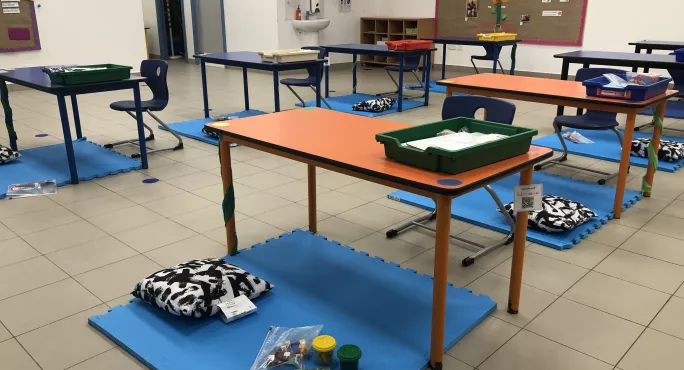- Home
- 3 reasons to let pupils turn desks into ‘learning dens’
3 reasons to let pupils turn desks into ‘learning dens’

Children have an innate ability to see everyday items as something magical and unique. Take the living room couch for, example; a mere piece of furniture to most adults.
To the young mind, however, a couch is a fortress at your fingertips, a den waiting to be built. For me, it was a place for my imagination to run wild, a safe haven to hide from my sisters, and a place where I could explore new books, ideas and interests. Overall, a den is childhood fun at its finest.
This is why, with my Year 2 classroom now socially distant with children assigned their own desk, I decided instead to let them turn their desks into dens. The results have been magic.
Here’s how it works and the benefits it delivers.
How to build a ‘learning den’
The desk and chair remain in place, while an activity mat and cushion underneath the desk immediately create a new space for students to learn in.
We started by borrowing mats from the PE department but are now in the process of buying some specifically for the classroom at around £10 each.
Pupils can then begin to add resources they need to their den such as cubes for maths, a hundred square and all the materials that may have previously been in a shared space or area.
When to use your learning den
Now that your classroom full of learning dens has been created, it’s time to explore how and when to use it.
During instructional time, students are more likely to use their learning den as a more traditional desk, either seated or standing.
But it’s during independent or collaborative learning when you see the learning den truly come to life.
When pupils are having a pair discussion, for example, I find most of my class seated or lying in their learning den, conversing with their partner across the way.
By allowing pupils to converse in this way rather than simply sitting at their desks, I have seen a huge impact on their confidence and willingness to share their ideas with peers.
Establishing a simple but clear set of rules on how and when to use learning dens is instrumental to the success of this approach in the classroom, and when done effectively, it will allow you and your pupils to see benefits in three ways.
The 3 key classroom benefits of using learning dens
1. Pupil engagement
As soon as our pupils see their learning space as their own learning den that they are responsible for, you see a whole new sense pride in them.
Immediately they are more excited about their space and are willing to use it more creatively. After all, a desk is to be seated at - but a learning den is to be explored.
By enabling pupils to work in their learning den as they wish, they are more engaged in their learning.
2. Uniting distance learners and classroom pupils
Like many educators around the world, I am now delivering a blended learning model and we strive to equally engage students learning at home and in school.
As such, saying “Stand at your desk” might make perfect sense to a student learning in school, but distance learners may not be learning at a desk and could start to feel left out or upset.
However, if all pupils are invited to create their own learning den, they can all take part and follow the instructions.
By empowering our students at home and in school to create their own learning den, we are creating the united mindset that we are striving for.
3. Active Learning - the new way
By establishing learning dens, pupils can safely and actively use their space to learn in a distanced manner.
Pupils can add QR codes to the legs of their learning den - for example, a QR code for a thesaurus in English.
As children may no longer have access to shared copies of books, by equipping them with QR codes in their learning den, they have the learning materials they need to hand.
By situating these resources around the learning den (eg, one leg of the learning den is designated towards maths QR codes, one leg English and so on), students must get up and actively use their space to access the required resource.

Laminating a coloured circle in each corner of their learning den also allows pupils to be active while completing work which they may have traditionally done on a whiteboard. Each corner has either a red, blue, green or yellow circle.
In a phonics lesson, for example, rather than asking pupils to list their new words on their whiteboard, which does not require them to be active, ask them to write one new vocabulary word in each of the coloured circles.
This simple strategy allows pupils to be regularly moving throughout the lesson rather than being seated for long periods of time. The opportunities for how these circles can be used are endless.
Overall, these changes have made a big difference in how pupils view their socially-distant classroom that now has more of that touch of magic and excitment that a primary classroom should always contain.
Niall Crowley is head of Year 2 at Deira International School, Dubai. He is currently undertaking a master’s in educational leadership and management with the University of Bath

Keep reading for just £1 per month
You've reached your limit of free articles this month. Subscribe for £1 per month for three months and get:
- Unlimited access to all Tes magazine content
- Exclusive subscriber-only stories
- Award-winning email newsletters

